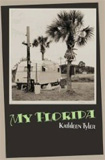Review by Karen J. Weyant
MY FLORIDA
by Kathleen Tyler
The Backwaters Press
3502 North 52nd Street
Omaha, Nebraska 68104-3506
ISBN: 978-0-9793934-6-4
70 pp., $16
www.thebackwaterspress.com
Palm trees swaying on sandy shorelines. Couples walking hand-in-hand into sunsets. College students going wild on spring break. Certainly, these images of Florida are often the first pictures that come to mind when we think of our Sunshine State. Kathleen Tyler’s My Florida, however, delivers a much darker landscape.
Tyler’s first poem, “Ars Poetica,” is significant to this collection. While “an art of poetry” poem seems to be a somewhat predictable way to start any collection of poetry, Tyler’s carefully measured lines serve the collection as a strong introduction:
They came on suddenly, storms did,
when I was eight. All morning I swung
upside down from a rope, arcing over
the lake. Trees strung from clouds. Hair raking
water, just beyond the snapping turtle’s bite.
Although we don’t know it quite yet, these opening lines show us what we will expect in from her collection: characters living in darkness within reach of danger. We see a landscape that seems ready to swallow a child whole, a dark world which will make its appearance again and again, along with characters eerily reminiscent of those found in the works of Flannery O’Connor.
What follows this first poem is a collage of the poet’s world. Narratives abound in bizarre works such as “Car Advertising Alligator Farm,” while with other poems, such as “Blind Couple in Tampa City Square Hall,” photographs are used as springboards for other tales. Sometimes Tyler’s work explores more current events; sometimes her poems dive into the past. Through this mixed media we hear poetic narratives from edges of society, and, certainly, the edges of what we know—or what we think we know—about the Sunshine State.
At first, such a collection of different poetic form and voices may seem to be a bit jolting to the reader. After all, from the very first poem Tyler dispels the paradise myth of Florida. Furthermore, Tyler’s work is not a traditional narrative, but instead a portrait, with many different pieces. Some pieces tell a single story. For example, in “Killing the Lobster” we see a persona who acknowledges her own violent streak:
…The best way
is to stab it between the eyes, plunge
a knife deep into its head. When I do it, it doesn’t
die immediately, but twitches, the way sea
grass must have rolled and flexed
as the trap was lifted from the sea.
And in “Roadside Landscape,” we see a disturbing mix of familiarity, sex and violence as we listen to the story of a young girl’s dark encounter with a male neighbor:
Hands grown monstrous from driving fence poles all day,
every day, he lifted me by my ankles, nightgown a nylon
cloud around my ears. Freckled people, he said,
are often pretty. Shaking loose, I ran to the bathroom
to shower from my thighs oily thumb prints
already blooming into bruises.
Other works are more surreal. “Poem With Sharp, Little Teeth” is a poem about a poem, or more specifically a work of art described as a creature that leaves the narrator with “a body perforated with bite marks,” suggesting the cruel environment of this world. In “Fairy Tale 1,” we don’t see what most of us would associate with traditional fairy tales: the description of a heron feasting on “hatchling alligators” and a father who spends his evenings, “killing possums with a shovel.” In fact, this poem may be seen as more of a metaphor for all living creatures who surrender themselves to the fate of death, especially when the poet tells us that the baby possums “playing dead” know somehow that “their time has come.”
But perhaps the most intriguing poems are those based after a series of photographs by Walker Evans, who is perhaps best known for his work capturing images of this country’s Great Depression. A short exploration of Evans, however, reveals that he also spent some time in Florida, photographing those who lived on the fringes of Florida’s more well-known world. Tyler uses several of Evans photographs as springboards for stories. For example, in “Photograph of Trailer in Camp Sarasota, 1944,” a woman explains that “back then, to be half Seminole/ was worse than being full black…” In “Ruin, Tabbey Construction, 1941,” a young girl tells stories of her past by describing her environment:
……….Hordes
of cockroaches left homeless
clicking down the night
hall. I slept in the bathtub, sheet
spread edge to edge. They found me
anyway, papery wings shuddering
against my cheek.
Whatever voice comes through Tyler’s poems, whether it is the voice of a child, or a mother, or a loved one from the past, the pictures are clear in their sensory details. You will feel the thick heat of the south, you will taste the sour drops of booze, and you will hear the birds, the insects, the snakes. This collection is, as Tyler’s title reveals, My Florida, and while the poems may not necessarily be the welcome mat that most of us would expect to see for one of our most popular states, they are an invitation to a world we all should see.
Comments are closed.